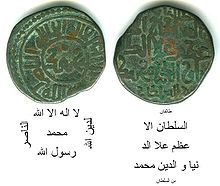an-Nāsir li-Dīn Allah

Abū l-ʿAbbās Ahmad ibn al-Mustadī ' ( Arabic ابو العباس أحمد بن المستضيء, DMG Abū l-ʿAbbās Aḥmad ibn al-Mustaḍīʾ ; * 1158 ; † October 2, 1225 ) with the throne name an-Nāsir li-Dīn Allāh (الناصر لدين الله / an-Nāṣir li-Dīn Alāh / 'the one who helps the religion of God to victory') was the thirty-sixth caliph of the Abbasid dynasty from 1180 to 1225 . Along with the Fatimid al-Mustansir (1036-1094) and the Seljuk Sandschar (1118-1157), he was one of the longest ruling rulers in Islamic history.
politics
An-Nāsir li-Dīn Allāh succeeded his father al-Mustadī ' (1170-1180). First he intervened with the Seljuks and fueled the power struggles there. Despite some setbacks, he was able to initiate the destruction of the Seljuk Empire (1194) through good relations with the Khorezm Shahs . But soon there were also disputes with the Anuschteginids over rule over western Persia, with the troops at-Nāsirs initially being driven out.
Since he now allied himself with the Ghurids in what is now Afghanistan against the Khorezm Shah Muhammad II , the latter advanced on Baghdad in 1217 , but had to withdraw because of a severe winter. It is disputed whether an-Nāsir, in view of the threatening power of his archenemy, made contact with the Mongols under Genghis Khan and thus conjured up the Mongol conquest of the Islamic east. At least this is what some Muslim chroniclers accuse an-Nāsir of.
In addition to his foreign policy work, an-Nāsir was able to further strengthen the authority of the caliphs within his Iraqi territory through the reorganization of the Futuwwa leagues . The Futuwwa movement emerged from Sufism in Anatolia in the 13th and 14th centuries . It was about male associations of the urban population, which an-Nāsir joined and whose members had to swear personal loyalty to the caliph. Rulers of other empires were also accepted into this covenant and thus subordinated to the caliph. With the instrument of the Futuwwa League, an-Nāsir had created an instrument for securing power for the caliphate , which was independent of feudal powers.
Patronage of religion and science
An-Nāsir promoted the Sufi sheikh ʿUmar as-Suhrawardī . He made him head of a ribat in Baghdad in 1183 and appointed him public preacher in 1205. As-Suhrawardī rose through An-Nāsir's patronage to one of the most prominent personalities of Baghdad and carried out several diplomatic missions for the caliph, for example to the Ayyubids in 1207/08, to the Khorezm Shahs in 1217/18 and to the court of rum in 1221 -Seljuks Kai Kobad I.
In addition, the caliph also promoted science. Several educational establishments and libraries were built or expanded. However, the doctrine of the Muʿtazila and the spread of Hellenistic philosophy were opposed. As a result, there were several book burnings and punishment for uncomfortable free thinkers and philosophers who pursued such ideas.
After an-Nāsir's death on October 2, 1225, his son az-Zāhir (1225-1226) succeeded him on the throne.
literature
- Angelika Hartmann : an-Nāṣir li-Dīn Allāh (1180-1225). Politics, religion, culture in the late Abbasid period ( studies on the language, history and culture of the Islamic Orient. NF Volume 8), Berlin / New York 1975.
- Angelika Hartmann: an-Nāṣir li-Dīn Allāh. In: The Encyclopaedia of Islam . New Edition Volume VII, pp. 996b-1003a.
supporting documents
- ↑ List of Abbasid caliphs . In: Wikipedia . March 17, 2020 ( wikipedia.org [accessed March 24, 2020]).
- ^ Erik Ohlander: Sufism in an Age of Transition: Umar al-Suhrawardī and the Rise of the Islamic Mystical Brotherhood . Brill, Leiden, 2008. pp. 89-112.
| predecessor | Office | successor |
|---|---|---|
| Al-Mustadī ' | Abbasid Caliph 1180–1225 |
az-Zāhir bi-amr Allāh |
| personal data | |
|---|---|
| SURNAME | Nāsir li-Dīn Allaah, an- |
| ALTERNATIVE NAMES | Abu l-Abbas Ahmad ibn al-Mustadi an-Nasir li-Dini llah |
| BRIEF DESCRIPTION | 34. Abbasid Caliph (1180–1225) |
| DATE OF BIRTH | 1158 |
| DATE OF DEATH | October 2, 1225 |